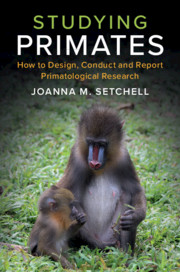Book contents
- Studying Primates
- Studying Primates
- Copyright page
- Dedication
- Contents
- Preface
- Acknowledgements
- 1 Asking Questions about Primates
- 2 Ethics in Primatology
- 3 Keeping Science Healthy: Research Integrity
- 4 Inclusive Science
- 5 Understanding Statistical Evidence
- 6 Communicating Ideas in Writing
- 7 Introduction to the Primates
- 8 Why Study Primates?
- 9 Identifying a Research Question
- 10 Finding Out What We Know
- 11 Reading Journal Articles
- 12 Formulating Hypotheses and Predictions and Designing a Study
- 13 Observing and Manipulating
- 14 Choosing Measures
- 15 Planning Data Analysis
- 16 Sampling and Statistical Power
- 17 Checking Feasibility and Finalising Your Plans
- 18 Writing a Research Proposal
- 19 Collecting Data
- 20 Conducting Fieldwork
- 21 Analysing and Interpreting Data
- 22 Writing a Scientific Report
- 23 Submitting to a Peer-Reviewed Journal
- 24 Presenting Your Work at a Conference
- 25 Conclusions
- Index
- References
7 - Introduction to the Primates
Published online by Cambridge University Press: 19 September 2019
- Studying Primates
- Studying Primates
- Copyright page
- Dedication
- Contents
- Preface
- Acknowledgements
- 1 Asking Questions about Primates
- 2 Ethics in Primatology
- 3 Keeping Science Healthy: Research Integrity
- 4 Inclusive Science
- 5 Understanding Statistical Evidence
- 6 Communicating Ideas in Writing
- 7 Introduction to the Primates
- 8 Why Study Primates?
- 9 Identifying a Research Question
- 10 Finding Out What We Know
- 11 Reading Journal Articles
- 12 Formulating Hypotheses and Predictions and Designing a Study
- 13 Observing and Manipulating
- 14 Choosing Measures
- 15 Planning Data Analysis
- 16 Sampling and Statistical Power
- 17 Checking Feasibility and Finalising Your Plans
- 18 Writing a Research Proposal
- 19 Collecting Data
- 20 Conducting Fieldwork
- 21 Analysing and Interpreting Data
- 22 Writing a Scientific Report
- 23 Submitting to a Peer-Reviewed Journal
- 24 Presenting Your Work at a Conference
- 25 Conclusions
- Index
- References
Summary
Primates are an order of mammals which share a set of traits inherited from a common ancestor that distinguishes them from all other mammals. These derived traits are not all unique to primates and none of the individual traits is shown by all primates. Primates range in body mass from the 30 g Madame Berthe's mouse lemur to around 250 kg for a male Grauer's gorilla. This variation in size is in line with that found in other mammalian orders and is closely associated with what they eat (diet), how they move (locomotion), and their behaviour. In this chapter, I provide a general introduction to the primates and their evolutionary adaptations (traits produced by natural selection for their current function), including their distribution and habitats, adaptations to life in the trees, diet and dietary adaptations, brains and sensory traits, life history and reproduction, behaviour and locomotion, social behaviour and interactions with other species. I then survey the major groups of primates. Throughout the chapter, I highlight terms that are common in the literature but are problematic.
- Type
- Chapter
- Information
- Studying PrimatesHow to Design, Conduct and Report Primatological Research, pp. 97 - 118Publisher: Cambridge University PressPrint publication year: 2019
References
Further Reading
7.11 Further Reading
*These books use the prosimian/anthropoid distinction rather than strepsirrhine/haplorrhine. Don’t copy this.

